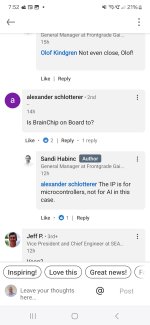JDelekto
Regular
Hi Dodgy,
This EETimes article dated 4 April 2024 provides the following details on Arm's U85 NPU.
View attachment 62809
I wonder how this U85 NPU's performance compares with the performance capabilities of AKIDA combined with Arm Cortex M-85? I remember watching Nandan's Arm Tech Talk in which he delved into AKIDA-P combined with Cortex M-85 but I don't beleive that he discussed any actual performance details unless I'm mistaken?
You would have to think that the comparative results exist somewhere and surely they would have to show show more than 4 TOPs performance.
The extract below is VERY interesting especially when you think that AKIDA 2.00 has been scaled up to 131TOPS.
EXTRACT
View attachment 62810
BrainChip published a document noting that 2 nodes on 14nm running @ 1GHz speed, will perform at about 1 TOPS or Tera Operations per second (or one trillion operations per second). 256 nodes will scale up to 131 TOPS. Higher clock speeds can be used if you scale to 7nm, so theoretically, it could be above 131 TOPS. Keep in mind that this supported 4-bit activations, whereas it seemed that demand was for up to 8-bit activations.
In a cursory look, I didn't find the performance measurements (in TOPS) of the AKD1000 processor and reference board. However, it is important to note that the manufactured chips were 28nm, and from Anil's presentation, contained 20 nodes (a total of 80 NPUs) in its neural fabric. He noted that this could run two or three different networks depending on the application.
Now Akida 2.0, according to this article, scales up to 128 nodes and 50 TOPS. This is a guess, but I wonder if the scalable support for up to 128 nodes (half that of Akida 1.0) is due to allowing 8-bit activations.
There was an interesting article on TOPs and why it is important for AI. They cite the speeds of various other processors (assuming they are accurate), such as Qualcomm's Snapdragon X Elite NPU running at 45 TOPS, and Intel's Lunar Lake CPUs with an NPU running at 45 TOPS. They also point out that a larger TOPS number is not necessarily better if the NPU is tuned for a specific task at a lower number of operations per second. BrainChip can run with the big dogs, yet they don't get the attention they deserve.
The article also quotes another Tom's Hardware article that points out that next-generation AI PCs will require about 40 TOPS of NPU performance. This, of course, is something that Akida 2.0 could easily accomplish if tuned to do this task. While targeting the Edge market, it seems like Akida could have the opportunity to participate in the next wave of AI PCs if they play their cards right.


